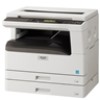Sharp MX-M200D Operation Manual - Page 22
Loading paper in the bypass tray, Important points when inserting, paper in the bypass tray - weight
 |
View all Sharp MX-M200D manuals
Add to My Manuals
Save this manual to your list of manuals |
Page 22 highlights
BEFORE USING THE PRODUCT Loading paper in the bypass tray 1 Open the bypass tray. Important points when inserting paper in the bypass tray • Up to 100 sheets of standard copy paper can be set in the bypass tray. • Be sure to place A6 and B6 (5-1/2" x 8-1/2") size paper and envelopes horizontally as shown in the following diagram. Pull out the bypass tray extension to load B4 and A3 (8-1/2" x 14" and 11" x 17") size paper. 2 Set the bypass tray guides to the paper width. 3 Insert the copy paper (print side down) all the way into the bypass tray. Make sure that the print side of the paper is face down. To prevent a misfeed, verify once more that the bypass tray guides are adjusted to the width of the paper. Note • If you loaded paper in the bypass tray, press the [PAPER SELECT] key to select the bypass tray. • If you load thick paper in the bypass tray, press the [PAPER] key until "EXTRA" is highlighted. The paper type is set to thick paper. The setting is cleared when "Auto clear" works or the [CA] key is pressed. For restrictions on paper types and weights, see "PAPER" (page 18). • When loading envelopes, make sure that they are straight and flat and do not have loosely glued construction flaps (not the closure flap). • Special papers except SHARP recommended transparency film, labels, and envelopes must be fed one sheet at a time through the bypass tray. • When adding paper, first remove any paper remaining in the tray, combine it with the paper to be added and then reload as a single stack. The paper to be added must be the same size and type as the paper already in the tray. • Do not use paper that is smaller than the original. This may cause smudges or unclean images. • Do not use paper that has already been printed on by a laser printer or plain paper fax machine. This may cause smudges or unclean images. Envelopes Do not use the following envelopes, as misfeeds will occur. • Envelopes with metal tabs, clasps, strings, holes, or windows. • Envelopes with rough fibers, carbon paper, or glossy surfaces. • Envelopes with two or more flaps. • Envelopes with tape, film, or paper attached to the flap. • Envelopes with a fold in the flap. • Envelopes with glue on the flap to be moistened for sealing. • Envelopes with labels or stamps. • Envelopes that are slightly inflated with air. • Envelopes with glue protruding from the seal area. • Envelopes with part of the seal area peeled off. 20















